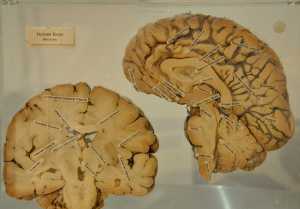09 Jun Genes Linked To Large Brains in Humans Identified
MedicalResearch.com Interview with:
 David Haussler PhD
David Haussler PhD
Investigator, Howard Hughes Medical Institute
Distinguished Professor, Biomolecular Engineering
Scientific Director, UC Santa Cruz Genomics Institute
Scientific Co-Director, California Institute for Quantitative Biosciences and
Sofie Salama, PhD
Research Scientist in BIomolecular Engineering
Howard Hughes Medical Institute Senior Scientist
MedicalResearch.com: What is the background for this study? What are the main findings?
Dr. Haussler: Researchers specializing in this area are interested understanding which evolutionary changes in our genome underlie human-specific brain features including our large (3X greater than chimpanzee) brain.
It has been my personal dream to peer into human evolution at the level of individual genes and gene functions.
MedicalResearch.com: What should readers take away from your report?
Dr. Salama:
1. NOTCH2NL are human-specific genes that arose via segmental duplication and related gene conversion events.
2. They are expressed in the neural stem cells of the developing cerebral cortex and encode secreted notch-related proteins that can activate notch signaling, which is essential to the self renewal and proliferation of this critical cell type.
3. Recurrent deletions and duplications caused by non-allelic homologous recombination between NOTCH2NLA and NOTCH2NLB underlie typical 1q21.1 distal deletions and 1q21.1 distal duplications, which are associated with a variety of neurological phenotypes.
MedicalResearch.com: What recommendations do you have for future research as a result of this study?
Dr. Salama: NOTCH2NL genes are a set of three nearly identical genes found only in humans that appear to play a critical role in the development of our large brains. They can activate Notch pathway signaling, which is important for regulating the balance between cortical neural stem cell self-renewal and differentiation. Increased levels of NOTCH2NL lead to more neural stem cells and decreased levels of NOTCH2NL to less.
MedicalResearch.com: Is there anything else you would like to add? Any disclosures?
Dr. Haussler:
- Co-senior author Frank Jacobs discovered that NOTCH2NL is highly expressed in human, but not macaque pluripotent stem cell derived cortical tissues while he was a postdoc with me and research scientist, Sofie Salama at UCSC. He has continued working on this project in his independent lab at the University of Amsterdam, contributing key new findings such as the subtle difference in activity in the
- Notch reporter assay displayed by the various alleles of NOTCH2NL that we have discovered in humans.
- Long stretches of repetitive DNA present challenges for DNA sequencing technologies. In fact, the location of NOTCH2NL in the human reference genome was not accurate when we first started investigating it. After checking other genomic data and contacting the team working on the next iteration of the reference genome, however, we found that NOTCH2NL is in fact located in the interval where the defects occur. Our team developed new methods to sequence and assemble this difficult genomic region which could be used to study other repetitive regions of the genome. Many similar regions exist that have been implicated in human evolution and disease.
- Interestingly, the 1q21.1 genetic changes described do not always result in neurological disorders. In about 20 to 50 percent of affected children, 1q21.1 syndrome is the result of a new genetic mistake. However, in many cases, one of the parents is found to also carry the genetic defect, without showing any apparent symptoms so other factors elsewhere in the genome must contribute to these phenotypes.
Citation:
Human-Specific NOTCH2NL Genes Affect Notch Signaling and Cortical Neurogenesis
The original Cell publication is available for anyone to access here: https://authors.elsevier.com/a/1X8ZRL7PXUgrM
Bonus content is available with the pre-press article here:
https://www.biorxiv.org/content/early/2017/12/11/221226
The information on MedicalResearch.com is provided for educational purposes only, and is in no way intended to diagnose, cure, or treat any medical or other condition. Always seek the advice of your physician or other qualified health and ask your doctor any questions you may have regarding a medical condition. In addition to all other limitations and disclaimers in this agreement, service provider and its third party providers disclaim any liability or loss in connection with the content provided on this website.
Last Updated on June 9, 2018 by Marie Benz MD FAAD
